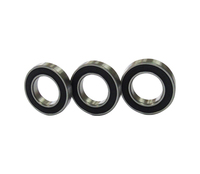Automotive Bearings applications
-
Car buyers often gauge vehicle quality by how a movement feels. Smooth motion with just the right degree of resistance signifies high quality while a mechanism with excess play feels loose and poor quality. Automotive manufacturers wanting to build a “quality” reputation should focus attention on that key component of every motion system: the automotive bearings.
Rolling vs. sliding
You'll find plenty of bearings inside every vehicle. These are either sliding or rolling element designs. Sliding bearings reduce friction with lubrication and specialized materials. These are found around the crankshaft and camshaft. Elsewhere, automotive manufacturers use bearings with balls or rollers that turn to minimize friction and provide a good “feel.”
Two types of motion
Most bearings are assembled into circular “races” that allow only circular motion. These are then assembled onto a shaft and installed in the housing. Tight control over manufacturing ensures balls or rollers are exactly the same diameter and surface finish, resulting in smooth, low-friction rotation.
Bearings are also used in linear systems, perhaps most notably, seat tracks. These are expected to provide smooth movement while withstanding high loads. Balls and rollers may be assembled loosely into stamped or roll-formed rails or installed into retainer assemblies.
Common bearing applications in automotive manufacturing
Rolling element bearings are used throughout the modern vehicle. They're in the cabin, under the hood and out at the corners. You'll even find bearing components – the balls themselves – used in the fuel system. Here's a closer look.
NINGBO MOSHENG BEARING CO., LTD. is a manufacturer of automotive bearings, and also has single row deep groove ball bearing and other products. Welcome customers at home and abroad to come to discuss cooperation.

